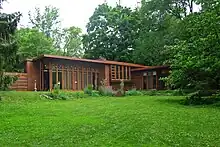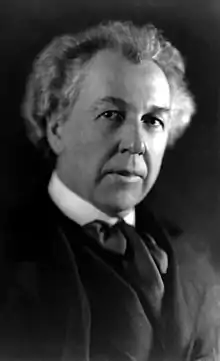The 20th-Century Architecture of Frank Lloyd Wright
The 20th-Century Architecture of Frank Lloyd Wright is a UNESCO World Heritage Site consisting of a selection of eight buildings across the United States that were designed by American architect Frank Lloyd Wright. These sites demonstrate his philosophy of organic architecture, designing structures that were in harmony with humanity and its environment. Wright's work had an international influence on the development of architecture in the 20th century.[1]
| UNESCO World Heritage Site | |
|---|---|
| Includes | Eight locations in the United States |
| Criteria | Cultural: (ii) |
| Reference | 1496 |
| Inscription | 2019 (43rd Session) |
| Area | 26.369 ha (65.16 acres) |
| Buffer zone | 710.103 ha (1,754.70 acres) |
Frank Lloyd Wright
Frank Lloyd Wright (1867–1959) was raised in rural Wisconsin and studied civil engineering at the University of Wisconsin. He then apprenticed with noted architects in the Chicago school of architecture, particularly Louis Sullivan. Wright opened his own successful Chicago practice in 1893, and developed an influential home and studio in Oak Park, Illinois. In the 20th century, he became one of the most renowned architects in the world.[2][3]
Nomination
Through efforts led by the Frank Lloyd Wright Conservancy, a non profit organization, the collection was originally put on the World Heritage Tentative List in 2008 with ten of Wright's buildings. It then grew to 11 sites in 2011, but the S. C. Johnson & Son Inc. Administration Building and Research Tower in Racine, Wisconsin, was eventually removed.[4][5] A 2015 bid for inscription was referred by UNESCO for revision in July 2016. The Conservancy led, Frank Lloyd Wright World Heritage Council, worked closely with the National Park Service and UNESCO to reconsider the original proposal and to make appropriate changes.[6]
In December 2018, a revised proposal[7] was submitted with eight buildings, excluding the Price Tower in Bartlesville, Oklahoma, and the Marin County Civic Center in San Rafael, California, from the proposal.[6] In the following June, the International Council on Monuments and Sites gave a positive recommendation.[8] The site was inscribed on the World Heritage list in July 2019.[9]
World Heritage listing
The eight representative Wright buildings selected for the World Heritage Site were designed in the first half of the 20th century. The first building included, Unity Temple (001), was completed in 1908. The last, The Guggenheim (008), was completed in 1959—the year Wright died—although its design began in the 1940s.
| Picture | ID[10] | Name | Location | Description | Coordinates | Property Area [Buffer Zone] |
|---|---|---|---|---|---|---|
 |
1496rev-001 | Unity Temple | Oak Park, Illinois | Completed in 1908, this unprecedented church building used reinforced concrete in novel ways, creating a light-filled space with the "colors of nature." Its use of this single material has caused it to be thought of as the first "modern building" in the world.[11] | 41°53′18″N 87°47′48″W | 0.167 ha (0.41 acres) [10.067 ha (24.88 acres)] |
 |
1496rev-002 | Frederick C. Robie House | Chicago, Illinois | This 1910 single-family home is considered a masterpiece of the Prairie School of architecture. Its "broad, sweeping horizontal lines; low, cantilevered roofs with overhanging eaves; and an open interior floor plan, . . . epitomizes Wright’s aim to design structures in harmony with nature."[12] A significant contributor to the concept of bringing nature indoors is the 175 leaded glass windows and doors, which feature a design of "abstraction of organic shapes".[13] | 41°47′23.4″N 87°35′45.3″W | 0.130 ha (0.32 acres) [1.315 ha (3.25 acres)] |
 |
1496rev-003 | Taliesin | Spring Green, Wisconsin | Begun in 1911 and never really finished,[14] Taliesin (Welsh for 'shining brow') became Wright's home, studio, and school of architecture. He built the large estate on the brow of a ridge, to be "'of the hill' not on it"[15] It is perhaps his most expansive and longest exploration of the organic theory of architecture and the Prairie School.[15] | 43°08′30″N 90°04′15″W | 4.931 ha (12.18 acres) [200.899 ha (496.43 acres)] |
.jpg.webp) |
1496rev-004 | Hollyhock House | Los Angeles, California | Wright's first commission in Los Angeles, Hollyhock House (built 1918-1921) was intended to be part of an arts colony and live theater complex in East Hollywood, built near the time the Southern California movie business was taking off. The work of Wright and his young apprentices became a springboard to what became known as California Modernism.[16] The structure "seamlessly integrates the indoors with outdoor gardens and living spaces".[17] | 34°05′59.85″N 118°17′40.61″W | 4.608 ha (11.39 acres) [13.986 ha (34.56 acres)] |
 |
1496rev-005 | Fallingwater | Mill Run, Fayette County, Pennsylvania | Built as a summer home in 1935, Fallingwater epitomizes Wright's ideas of organic architecture. Placed as if "floating" over stream and waterfall, its cantilevered terraces of rock and geometric reinforced concrete spaces blend with the setting's natural rock formations. Wright wanted the couple that commissioned the work to not just look out at the stream on their summer property but "live with the waterfall . . . as an integral part of [their] lives". The American Institute of Architects has called Fallingwater "the best all-time work of American architecture".[18] | 39°54′22″N 79°28′5″W | 11.212 ha (27.71 acres) [282.299 ha (697.58 acres)] |
 |
1496rev-006 | Herbert and Katherine Jacobs House | Madison, Wisconsin | Built during the Great Depression, ideas for the Jacobs House (1937) grew out of an urban planning idea of Wright's that would provide a community of well-built, single-family affordable housing. Wright initially called this aesthetic Usonian, a word coined in the early 1900s for "American." Working within a budget of less than $5000, Wright combined his open design plan, functional spaces, and the use of wood, brick, dyed concrete, and large windows, to match a small landscaped neighborhood lot.[19][20] | 43°3′31″N 89°26′29″W | 0.139 ha (0.34 acres) [1.286 ha (3.18 acres)] |
 |
1496rev-007 | Taliesin West | Scottsdale, Arizona | In 1937 Wright began building his winter home, studio, and architectural fellowship center in the foothills of the Arizona's McDowell Mountains. The property was designed by Wright and his students, and built using timber, locally sourced stone, and a mixed sand concrete. Taliesin West was set within the landscape with overlapping indoor and outdoor rooms, a triangular garden of native plants, and triangular pool.[21] | 33°36′22.8″N 111°50′45.5″W | 4.285 ha (10.59 acres) [198.087 ha (489.48 acres)] |
.jpg.webp) |
1496rev-008 | Solomon R. Guggenheim Museum | New York, New York | Wright's work for the Guggenheim Foundation in the 1940s and 1950s re-conceived the modern museum building as a place in conversation with the art within.[22] Wright also thought it important to have the museum placed across from natural areas in Central Park, and he incorporated the sinuous forms of nature in the spiral structure.[2][23] | 40°46′59″N 73°57′32″W | 0.251 ha (0.62 acres) [2.164 ha (5.35 acres)] |

References
- "The 20th-century Architecture of Frank Lloyd Wright". UNESCO World Heritage Centre. Retrieved July 7, 2019.
- "The Architecture of the Solomon R. Guggenheim Museum". Guggenheim.org. Retrieved 2019-07-12.
- Miller, Hugh C. (1973), Chicago School of Architecture (PDF), United States Department of the Interior, pp. 8–9
- Kamin, Blair (29 January 2015). "Wright buildings to be nominated to list of significant world sites". Chicago Tribune.
- "Frank Lloyd Wright Buildings Nominated for UNESCO Heritage List". Solomon R. Guggenheim Foundation. 17 February 2015.
- "Eight Buildings Designed by Frank Lloyd Wright Nominated to the UNESCO World Heritage List". Frank Lloyd Wright Foundation. 20 December 2018.
- "Eight Wright Sites Inscribed to UNESCO World Heritage List". Frank Lloyd Wright Building Conservancy. Retrieved 2019-07-13.
- "World Heritage Committee to meet in Baku (Azerbaijan) to examine inscription of new sites on World Heritage List". Mirage News. 20 June 2019.
- "Two cultural sites added to UNESCO's World Heritage List". UNESCO. July 7, 2019.
- "The 20th-Century Architecture of Frank Lloyd Wright : Multiple locations". UNESCO World Heritage Centre. Retrieved 7 July 2019.
- "Unity Temple". Frank Lloyd Wright Foundation. Retrieved 2019-07-10.
- Garcia, Evan (April 1, 2019). "Frank Lloyd Wright's Robie House Reopens After Massive Renovation". WTTW. Retrieved 2019-07-10.
- Desai, Sapna (April 22, 1019). "Robie House Reopens After Extensive Restoration". The Chicago Maroon. Retrieved 2019-07-10.
- Waldek, Stefanie (May 11, 2018). "7 Things You Didn't Know About Frank Lloyd Wright's Taliesin". Architectural Digest.
- "Taliesin". Frank Lloyd Wright Foundation. Retrieved 2019-07-10.
- "Hollyhock House". Barnsdall Art Park Foundation. Retrieved 2019-07-10.
- "Hollyhock House". Los Angeles Conservancy. Retrieved 2019-07-11.
- "Fallingwater". Frank Lloyd Wright Foundation. Retrieved 2019-07-11.
- "First Jacobs House". WTTW Chicago. 2016-03-26. Retrieved 2019-07-11.
- Wright, Amy Beth (2017-07-04). "Seven Hidden Gems from Frank Lloyd Wright's Usonian Period". Metropolis. Retrieved 2019-07-11.
- "Taliesin West". The Cultural Landscape Foundation. Retrieved 2019-07-11.
- Kamin, Blair (July 7, 2019). "Column: 8 Frank Lloyd Wright buildings, including Chicago's Robie House and Oak Park's Unity Temple, named to World Heritage List". Chicago Tribune. Retrieved 2019-07-12.
- "Organic Architecture". Guggenheim.org. 2010-09-08. Retrieved 2019-07-12.
